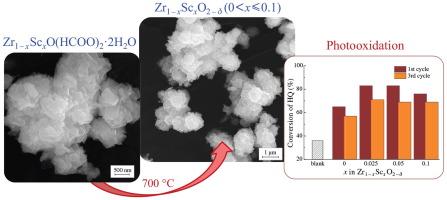合成掺杂钪的高分散 ZrO2 的前驱体方法
IF 1.7
4区 化学
Q3 CHEMISTRY, MULTIDISCIPLINARY
引用次数: 0
摘要
利用前驱体技术制备了 Zr1-xScxO2-δ (0 < x ≤ 0.1) 的固溶体,并研究了其结构、光学和光催化特性。前驱体采用了一种新方法合成的混合甲酸盐。钪有利于 ZrO2 在四方共轭体中的形成,并提高了其在紫外范围内的光活性。本文章由计算机程序翻译,如有差异,请以英文原文为准。

Precursor method for the synthesis of highly dispersed ZrO2 doped with scandium
The solid solutions of Zr1–xScxO2–δ (0 < x ≤ 0.1) were prepared using a precursor technology, and their structural, optical, and photocatalytic characteristics were studied. Mixed formates synthesized by an original method were used as precursors. Scandium favored the formation of ZrO2 in tetragonal syngony and increased its photoactivity in the UV range.
求助全文
通过发布文献求助,成功后即可免费获取论文全文。
去求助
来源期刊

Mendeleev Communications
化学-化学综合
CiteScore
3.00
自引率
21.10%
发文量
226
审稿时长
4-8 weeks
期刊介绍:
Mendeleev Communications is the journal of the Russian Academy of Sciences, launched jointly by the Academy of Sciences of the USSR and the Royal Society of Chemistry (United Kingdom) in 1991. Starting from 1st January 2007, Elsevier is the new publishing partner of Mendeleev Communications.
Mendeleev Communications publishes short communications in chemistry. The journal primarily features papers from the Russian Federation and the other states of the former USSR. However, it also includes papers by authors from other parts of the world. Mendeleev Communications is not a translated journal, but instead is published directly in English. The International Editorial Board is composed of eminent scientists who provide advice on refereeing policy.
 求助内容:
求助内容: 应助结果提醒方式:
应助结果提醒方式:


